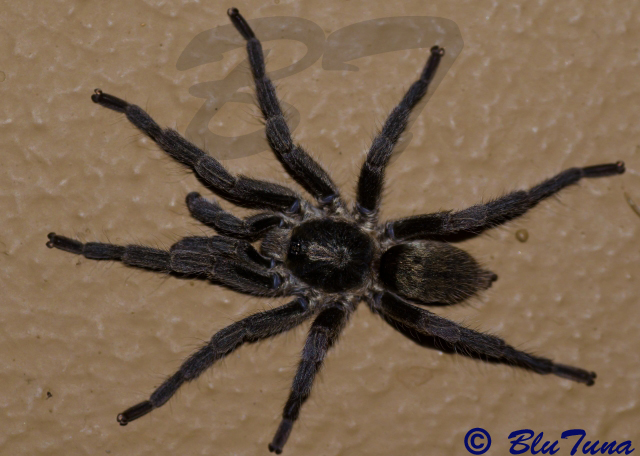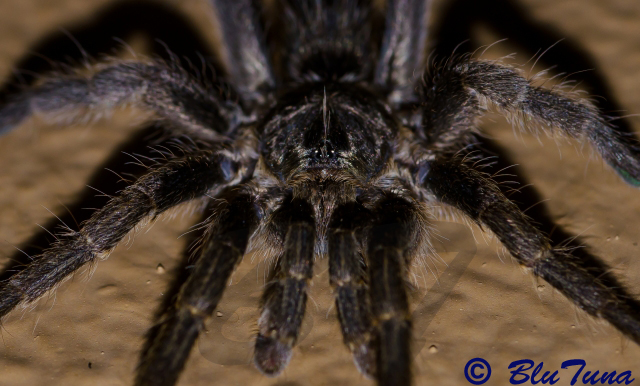Theraphosidae (Baboon Spiders)
The family Theraphosidae is a large family represented by 86 genera and about 612 species with a pantropical distribution. It includes the group of spiders known as Baboon Spiders in Africa and Tarantulas in the Americas. African species are called Baboon Spiders due to their hairy appearance and the black scopulae pads on its "feet" resembling the pads on baboon feet. From South Africa eight genera and 44 species are known of which 35 are endemic to the
region.
The most dramatic feature of these spiders is the black fangs that can exceed 6 mm in length and are parallel to each other (paraxial). The fangs are set into the jaws (chelicerae) that project forward (porrect). These spiders are black and hairy underneath (ventrally) except in the region of the fangs where the hair colour rnages from orange to a pink/red tinge. During an attack, the forelegs are raised in aggression, exposing the fangs and the orange and black colouration. Dorsally the colouration varies enormously ranging from black, various shades of brown and shades of copper and cinnamon. The abdomen can be plain or marked with spots or chevrons.
Life style
Wanderers (ground dwellers): live in terrestrial silk-lined burrows or retreats made under rocks.
Body size
Medium-sized to very large. Theraphosids are large, bulky and hairy with a body length of 13-90 mm long with the average spider measuring 20-50 mm.
Diagnostic characters
Colour: various hues of brown, from pale to dark; abdomen with variegated pattern.
Carapace: clypeus wide; the anterior (front) edge of the carapace is called the clypeus and if there is no clypeus, one can be assured that the spider is not a theraphosid but another family instead (either Barychelidae, Cyrtauchenidae or Nemesiidae). Fovea short, varies from straight to procurved, or provided with a distinct horn-like process or depression in
Ceratogyrus; hirsute; chelicerae outer face of chelicerae hirsute, or with dense scopulae and/or stridulating organs in Harpactirinae (except
Harpactirella and
Brachionopus); rastellum absent or weak; mouthparts anterior lobe of endites well developed into conical process; labium and endites with dense cuspules; sternum with moderately small, oval, marginal to subcentral posterior sigilla.
Eyes: eight; in two rows arranged on the carapace on a central tubercle set back slightly from the anterior (front) edge of the carapace.
Abdomen: : oval; hirsute; apical segment of posterior spinnerets long and digitiform; respiratory system four booklings.
Legs: two claws with tarsal scopulae and claw tufts; reduced spination on legs III-IV; paired tarsal claws, each with only one row of teeth; clavate trichobothria along length of tarsi. They have robust non-tapering legs and the pads or scopulae setae under the "feet" allow them to walk up the smoothest of surfaces - even glass.
In other spider families, the males are easily recognised by the expanded ends of the palps where the sperm-carrying organ, the embolus, is situated. The expanded palp ends are not that noticeable in male theraphosids but males can also be recognised by the less bulky abdomen and by a tibial spur situated ventrally on the distal aspect of the tibia of the first pair of legs. The spur is not obvious as it is concealed amongst long hairs (setae) and rather resembles a pointed brush. The spur is used to restrain the females' fangs during copulation.
Web and retreat
Web: absent. Retreat: All South African species are terrestrial occurring in underground burrows or scrapes under rocks. The scrape is lined with thick silk, which is attached to the rock and keeps out troublesome insects such as ants. At night, the burrow dwellers can be seen with their front legs and eyes showing at the entrance of their burrows as they wait for unsuspecting prey.
Females usually stay close to their retreat while the males, once mature, roam freely looking for a mate.
Habitat
More commonly found in the Grassland and Savanna Biomes, Nama-Karoo and the Kalahari desert.
Behaviour
Theraphosids are free-living spiders inhabiting terrestrial, silk-lined burrows, arboreal retreats or retreats made under rocks or in holes under bark or under epiphytes Nemesiids live in silk-lined burrows that vary in shape. Some species close their burrows with lids. The entrance is left open with some of the silk lining extending past the entrance to form a rim that sometimes incorporates pieces of plant material that may help with prey detection. In arid regions their burrows are usually deep, and provide them with protection from high temperatures. These spiders usually rest during the day in the deepest part of the burrow. They are predominantly sit-and-wait hunters and at night they wait for prey to approach, sitting in the entrance of the burrow or on the soil surface close to the burrow.
Prey remains and exuviae are stored mostly at the bottom of the burrow. Baboon spiders do not have rastellums and they seem to be opportunistic burrowers, extending other animal holes e.g. ants, moles and lizards. The eggs are deposited in an egg cocoon constructed at the bottom of the burrow. The juvenile spiders will remain with the female for some time before they disperse.
Prey consists of a variety of small invertebrates such as beetles, cockroaches, grasshoppers, millipedes, other spiders.
Reproduction
The female lays 30 to 180 eggs but very few survive the 7 to 10 year maturity period. Unlike the true spiders, the araneomorphs, the mygalomorph females continue to moult after reaching maturity and can live for about 25 years. The males live for only about 6 months after maturity and therefore it is of no consequence should the females consume them.
Venom
They are not dangerous to man although they can inflict a painful bite. They are all mildly venemous, the venom being neurotoxic.
Genera native to southern Africa:
Ceratogyrus, the horned baboon spider, is distributed across the northern parts of South Africa and its bordering countries.
Harpactira the common baboon spider, occurs over the whole of South Africa and bordering countries.
Pterinochilus, the golden-brown baboon spider occurs from north-eastern South Africa northwards to Ethiopia.
There are two lesser baboon spiders,
Brachionopus, which is rare and is restricted to the eastern parts of South Africa and
Harpactirella that occurs in the southern parts of South Africa.
Links:
Biodiversity Explorer;
Atlas of the Spiders of South Africa;
The baboon spiders of South Africa, by Dr Ansie Dippenaar-Schoeman






 © BluTuna
© BluTuna © BluTuna
© BluTuna